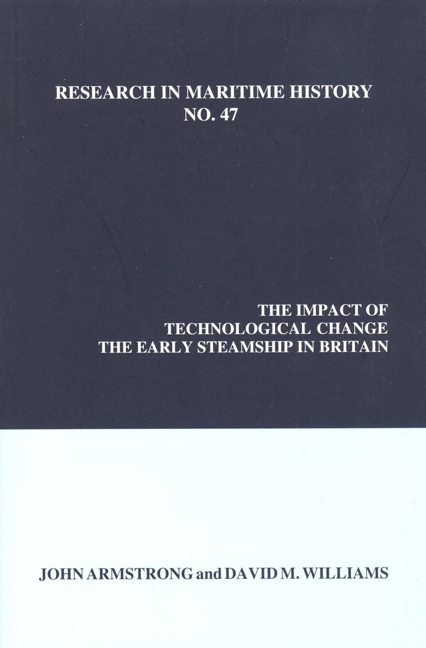Book contents
- Frontmatter
- Contents
- Series Editor's Foreword
- About the Authors
- Introduction
- Chapter 1 British Steam Navigation, 1812 to the 1850s: A Bibliographical and Historiographical Review
- Chapter 2 Some Official Listings of “Vessels Navigated by Steam” in Britain up to 1851: Evidence and Interpretation
- Chapter 3 The Steamboat, Safety and the State: Government Reaction to New Technology in a Period of Laissez-Faire
- Chapter 4 The Steamboat and Popular Tourism
- Chapter 5 The Thames and Recreation, 1815-1840
- Chapter 6 Steam Shipping and the Beginnings of Overseas Tourism: British Travel to North Western Europe, 1820-1850
- Chapter 7 Technological Advance and Innovation: The Diffusion of the Early Steamship in the United Kingdom, 1812-1834
- Chapter 8 The Steamship as an Agent of Modernisation, 1812-1840
- Chapter 9 “A New and Very Modern Business:” The Traffic and Operations of the Early Steamship
- Chapter 10 Promotion, Speculation and Their Outcome: The “Steamship Mania” of 1824-1825
- Chapter 11 The Perception and Understanding of New Technology: A Failed Attempt to Establish Transatlantic Steamship Liner Services, 1824-1828
- Chapter 12 The “Norwich Explosion” of 1817: A Local Tragedy of National Significance
- Chapter 13 Early Steamboat Services and Their Impact in North Wales, 1817-1840s
- Chapter 14 The Beginnings of a New Technology: The Constructors of Early Steamboats, 1812-1822
Chapter 14 - The Beginnings of a New Technology: The Constructors of Early Steamboats, 1812-1822
- Frontmatter
- Contents
- Series Editor's Foreword
- About the Authors
- Introduction
- Chapter 1 British Steam Navigation, 1812 to the 1850s: A Bibliographical and Historiographical Review
- Chapter 2 Some Official Listings of “Vessels Navigated by Steam” in Britain up to 1851: Evidence and Interpretation
- Chapter 3 The Steamboat, Safety and the State: Government Reaction to New Technology in a Period of Laissez-Faire
- Chapter 4 The Steamboat and Popular Tourism
- Chapter 5 The Thames and Recreation, 1815-1840
- Chapter 6 Steam Shipping and the Beginnings of Overseas Tourism: British Travel to North Western Europe, 1820-1850
- Chapter 7 Technological Advance and Innovation: The Diffusion of the Early Steamship in the United Kingdom, 1812-1834
- Chapter 8 The Steamship as an Agent of Modernisation, 1812-1840
- Chapter 9 “A New and Very Modern Business:” The Traffic and Operations of the Early Steamship
- Chapter 10 Promotion, Speculation and Their Outcome: The “Steamship Mania” of 1824-1825
- Chapter 11 The Perception and Understanding of New Technology: A Failed Attempt to Establish Transatlantic Steamship Liner Services, 1824-1828
- Chapter 12 The “Norwich Explosion” of 1817: A Local Tragedy of National Significance
- Chapter 13 Early Steamboat Services and Their Impact in North Wales, 1817-1840s
- Chapter 14 The Beginnings of a New Technology: The Constructors of Early Steamboats, 1812-1822
Summary
Relatively little academic study has been undertaken on early British steamboats, where “early” is taken to be the first half of the nineteenth century. Research has focussed on the second half of the nineteenth century when greater boiler pressures gave rise to the compound, and later the triple expansion engine - both much more economic in their coal consumption - which allowed long ocean voyages to be undertaken. Even less has been published on the “very early steamboat,” which we might take as meaning from the in ception of European commercial steamboat services in 1812, when Henry Bell ran Comet on the river Clyde between Glasgow and Helensburgh, until the mid-1820s. Of the steam vessels of this period there has been an absence of thorough academic analysis, especially in the matters of their construction and the builders and engineers involved. A powerful reason for this neglect may well have been that there was perceived to be no single, easily usable source. The authors of this article have discovered a previously unused source that allows us to address a number of questions about the very early steamboats.
The article is in five sections. First, the source is explained and some reasons advanced for its neglect to date. The source is then tested in terms of its authorship and completeness against such other contemporary evidence as is available. Second, the validity of the source having been established, it is summarized in terms of the general trends of numbers constructed, tonnage and horsepower. The two following sections present an examination of the construction of the very early steamboats. Here a key factor is that in the early decades of steam navigation hull building and engine manufacture were separate, distinct and unrelated activities, primarily because each involved different skills associated with very different materials, wood and iron. Moreover, not merely were hull and engine building undertaken separately, but they often took place in locations a considerable distance apart. Hence, the third section considers the matter of who provided the hulls for early steam vessels and the location of their shipyards, while a fourth section poses similar questions of engine builders. A fifth section integrates the analysis and comments on theories of innovation dispersal. The conclusion places the findings in a longerterm context.
- Type
- Chapter
- Information
- The Impact of Technological ChangeThe Early Steamship In Britain, pp. 277 - 300Publisher: Liverpool University PressPrint publication year: 2011



